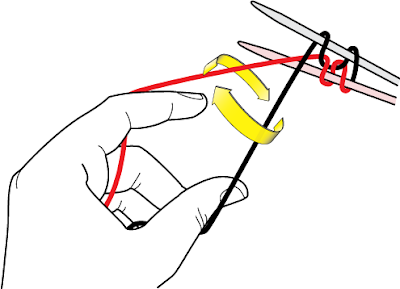Fundamentally, Judy's Magic Rib breaks down into just four components:
- Cast on in knit.
- Transition from knit to purl.
- Cast on in purl.
- Transition from purl to knit.
This post will focus on the Transitions because we have already covered how to cast on in knit and purl in previous posts (here and here). In the transitions, you will:
- Bring both strands of yarn through the middle between the two needles, to the other side.
- Rotate the yarns one half-twist.
I have to warn you: the kinetics are tricky. You'll be moving two strands of yarn towards you vs. away from you AND rotating in one direction vs. another. It took me *many* attempts to understand how this works. I dearly hope that my efforts to make this technique understandable to you have not been in vain!
The example below is for k2p2 rib.
1. Cast on 2 sts in JMCO-knit.
Start on the bottom needle, end on the top needle. For a refresher on how to do this, click here.
2. Transition from knit to purl.
1. Bring both strands of yarn between the two needles, from back to front. Be careful to not let that last stitch slip off! (It's easier if you first bring the yarns together with your thumb & forefinger, then bring them through the middle.)
2. Rotate the yarns around each other to un-cross them. This is a bit of a pain, because you have to reposition the yarn in your left hand, and switch which finger holds which end of the yarn.
The image below shows this in principle. The three images that follow show how I do it (which you can ignore, if you want to use a different set of movements).
Before I show you how, first I'm going to point out to you that when you're doing JMCO-knit, you hold the tail (red) with your forefinger and the working yarn (black) with your thumb. Whereas when you're doing JMCO-purl, it's the opposite: the working yarn goes on your forefinger, and the tail goes on your thumb. In both cases, the working yarn gets wrapped around the top needle, and the tail gets wrapped around the bottom needle. In theory, if our wrists could rotate another 180 degrees in either direction, it wouldn't matter which finger held which strand, but we humans have our limitations.
So, this is why, when you transition from knit to purl and purl to knit, you have to switch yarn positions.
Hope that makes sense. :)
Here's how I rotate the yarns from JMCO-knit to JMCO-purl...
Note that I used to drop both ends of the yarn, rotate them, and pick them up again. Doing that for each and every transition got old really fast. I eventually figured out this method, which I like a lot better.
(a) With your thumb, let go of the working yarn. Bring your thumb under and behind the working yarn, then up and and in front of the tail.

(b) Now that your thumb is holding the tail, release your forefinger. With your thumb, swing the tail down, behind the working yarn.
(c) Now grab the working yarn with your forefinger, and swing it out.

Transition done! Now you're ready to continue casting on in purl.
3. Cast on 2 purl stitches. Remember how to do this? :) Refresher is here.

Throw the working end over the top needle with your forefinger.


2. Rotate the strands of yarn around each other, so that the tail crosses behind the working end. Note that this time you are rotating them in the opposite direction as you did for Step 2.
In principle:
Here's how I rotate the yarns from JMCO-purl to JMCO-knit:

(b) Now that your forefinger has the tail, release your thumb. With your forefinger, swing the tail up and behind the working yarn.
Now you're ready to cast on more knit stitches. Remember how do to this? :) Refresher is here.

Bring the working yarn behind the bottom needle and in front of the top needle...





.png)




I have been noodlin' with this very idea for the past few months, but from the top needle. Nicely done.
ReplyDeleteI finally practiced this - very cool! You really have a good grasp on visualizing stitches and their kinetics :-)
ReplyDeletei am learning so much!! thank you!
ReplyDeleteI get (what I think is?) the same result if I turn the needles over - alternating turning them away from me for two stitches on each needle and turning them toward me for two stitches on each needle - but still taking the pair of yarns between the needles, of course... I'm going to practice your way, it looks good!
ReplyDelete